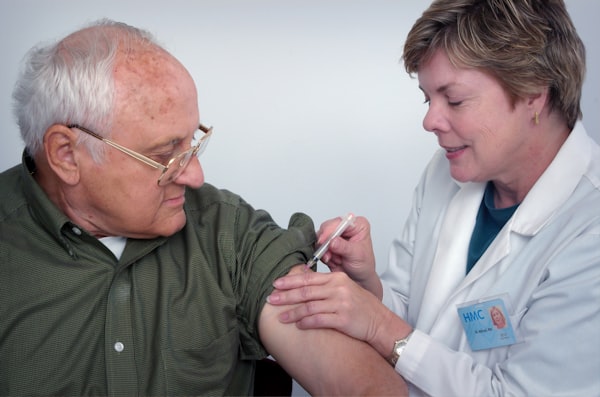What is the Difference Between Hallucinations and Delusions?
Hallucinations involve sensing things that aren’t real, like hearing voices or seeing objects, while delusions are false beliefs held despite evidence. Understanding the difference helps caregivers and loved ones support those experiencing these symptoms.

Welcome to this guide exploring the difference between hallucinations and delusions. This guide will examine the characteristics, causes, and treatments of both hallucinations and delusions to provide you with a deeper understanding of the two conditions.
Hallucinations and delusions are two distinct neurologically based phenomena that can occur independently, or they can sometimes both be present in a single individual. Though many people use the terms interchangeably, there are important distinctions between the two.
Hallucinations involve perceiving sensory input even when there is no external stimulus, while delusions require an individual to have a false belief about reality. Having a better understanding of the subtle yet important differences between the two can help you know when to seek medical help.
Hallucinations and delusions are two kinds of psychological phenomena that have been recognized by the mental health community for centuries. They have both been described as symptoms of mental disorders and can be seen in cases of psychotic and non-psychotic disorders. Despite being similar in some ways, hallucinations and delusions are distinct experiences that often need to be treated differently.
Hallucinations are sensory experiences that occur without any external stimuli. These ‘hallucinations' may be experienced in any of the five senses: sight, sound, taste, smell, and touch. They can range from mild to severe in intensity and duration, and usually involve perceiving something that others cannot. For example, one may experience seeing flashes of light or hearing voices when no one else is present.
Delusions are beliefs that are held despite evidence that they are false or irrational. They can involve a variety of topics and themes, and involve an inability to question or doubt the belief even when presented with contradictory information or evidence. An example of a delusion is believing that the government is plotting against you even though there's no proof or evidence to support this belief.
Both hallucinations and delusions are common symptoms of psychosis and can be present in individuals suffering from bipolar disorder, schizophrenia, depression, and other mental illnesses. However, it is important to note that hallucinations and delusions can also occur in healthy individuals, so it is important to seek professional help if these symptoms persist or become overwhelming.
Understanding Hallucinations and Delusions
Hallucinations and delusions are two types of symptoms that can occur in individuals with mental health conditions, such as schizophrenia, bipolar disorder, and Alzheimer’s disease. Hallucinations are false perceptions that involve seeing, hearing, tasting, smelling, or feeling something that is not there. For instance, a person might hear voices when no one is speaking or see objects that aren’t present. Delusions, on the other hand, are false beliefs that are not based on reality. These beliefs are often resistant to reason or contrary evidence. Both hallucinations and delusions can be distressing and can interfere with a person’s daily life, making it crucial to understand and address these symptoms effectively.
Characteristics of Hallucinations and Auditory Hallucinations

Hallucinations are a type of psychological experience where a person experiencing them perceives or experiences something that is not real. It is common for people with mental health conditions, such as schizophrenia, to experience hallucinations. As hallucinations are subjective, it is difficult to describe them without someone having experienced them, but there are some general characteristics associated with them.
Some physical characteristics of hallucinations include seeing, hearing, or feeling things that aren’t actually there. The person may hear voices, see images, or feel sensations that no one else can perceive. Hallucinations can often occur at night or in dark places and may become worse during times of stress or fatigue.
Psychologically, hallucinations can have a range of effects on a person. They can be distressing or pleasant, depending on the content of the hallucination. Some people may find that the experience of hallucinating is confusing or even overwhelming. Others may find the experience pleasurable and seek out hallucinogenic drugs to produce similar effects.
Hallucinations can also be associated with strong emotions or memories. People who experience hallucinations may be unable to control their feelings or thoughts and may struggle to make sense of the experience. It is important to note that, despite the intensity of the experience, hallucinations are not real.
Characteristics of Delusions and False Beliefs
Delusions are false beliefs that can’t be changed even when presented with facts or evidence to the contrary. These beliefs tend to be quite persistent and fixed, so even when presented with evidence to the contrary, an individual with a delusion will still maintain the belief or opinion. They can cause a person to become significantly distressed, as they appear to take the delusion as absolute truth.
Hallucinations and delusions are both symptoms of psychosis, but they differ in that hallucinations involve sensory experiences while delusions are false beliefs.
Physical characteristics of delusions can include an increase in energy levels, rapid speech, difficulty sleeping, restlessness, and agitation. Psychological characteristics of delusions can include a decrease in concentration levels, confusion and disorientation, difficulty problem solving, a decrease in coping mechanisms, and an inability to accept reality.
Delusions are also often described as being bizarre, involving wild, far-fetched ideas that just don’t fit into reality. The content of delusions can range from persecutory delusion, grandiose delusions, somatic delusions, jealous delusions, and many more.
Hallucinations and delusions are two distinct characteristics that can come with different types of mental health conditions. Aside from being a symptom of such conditions, they can also be experienced as part of a normal and healthy life experience. It’s important to understand the differences between them and their individual symptoms, in order to recognize when someone might need professional help.
Hallucinations involve perceiving things that are not actually there, and can occur in any of the five senses. People can experience auditory (hearing), visual (seeing), olfactory (smelling), gustatory (tasting), or tactile (feeling) hallucinations. Visual hallucinations are the most common type, often involving seeing people, animals, or objects that aren’t actually there. Auditory hallucinations consist of hearing voices or sounds that don’t actually exist, and are common in people who suffer from schizophrenia. Olfactory, gustatory, and tactile hallucinations can also occur, and may involve strange smells, tastes, or physical sensations that aren’t real.
Delusions, on the other hand, are false beliefs that are held despite overwhelming evidence to the contrary. People experiencing delusions might believe something is true even when there’s no way it could be true. Delusions can come in many forms, from grandiose delusions that involve an inflated sense of importance or power, to persecutory delusions characterized by the fear of being chased, followed, or watched. Delusions can be very convincing and difficult to shake off, which is why it’s important to recognize them and seek out professional help if they persist.
Hallucinations and delusions can both be incredibly frightening experiences, but understanding the differences between them can go a long way towards helping those who experience them. Knowing how to recognize these symptoms, and where to turn for help, is key to managing mental health conditions and getting support when it matters most.
Hallucinations and delusions are both conditions that involve distorted perceptions and beliefs. Although they share some similarities, there are significant differences between the two. It is important to understand the potential causes and risk factors associated with each condition as these can help inform diagnosis and treatment.
When it comes to hallucinations and delusions, understanding the potential causes and risk factors can provide valuable insight into diagnosis and treatment. The exact causes for each condition vary, but there are certain factors that can increase the likelihood of developing either.
Hallucinations may be caused by a number of things, including drug use, medical conditions, psychological disorders, and aging. Any of these can lead to sudden and persistent hallucinations, with a variety of symptoms. Psychological disorders such as borderline personality disorder, schizophrenia, bipolar disorder, and post-traumatic stress disorder also may cause hallucinations.
Delusions are more complex, and can be caused by a wide range of underlying issues. Mental health disorders like depression, anxiety, and schizophrenia can all lead to delusional thinking. In addition, substance abuse, fatigue, dementia, physical injuries, and medication side effects have all been linked to causes of delusions.
In addition to potential causes, there are certain risk factors for both conditions. People who have a family history of mental illness, have experienced emotional trauma or physical illness, or take certain medications are at an increased risk for developing delusional thinking or hallucinations. Other risk factors can include age (older individuals may be more likely to experience delusions or hallucinations) as well as chronic stress, poor sleep habits, and nutritional deficiencies.
Discernment and awareness of the potential causes and risk factors related to hallucinations and delusions can help inform diagnosis and treatment. By being aware of the ways in which these conditions can develop, people can establish a course of action that can help them manage their symptoms.
Treatments for Hallucinations and Delusions Hallucinations and delusions can have a significant impact on people’s lives. Fortunately, there is help available to manage the symptoms. The aim of treatment is to reduce the severity or frequency of symptoms, improve the individual’s functioning and overall quality of life. Treatment approaches vary depending on the individual, but these are some of the most common treatments used to address hallucinations and delusions.
Medication Medication can be used to help manage delusions and hallucinations. Antipsychotic medications, such as risperidone, olanzapine and quetiapine, are the most commonly prescribed type of medication. These drugs helps to reduce or eliminate psychotic symptoms and can be taken in pill form or as an injection. It is important to speak to a doctor before taking any medications and find out about potential side effects.
Psychotherapy Talking therapy, also known as psychotherapy, can be helpful for those experiencing persistent mental health conditions. There are various types of psychotherapy, such as cognitive behavioral therapy (CBT) and solution-focused therapy, which can help individuals understand their symptoms, identify unhealthy thinking patterns and establish new ways of thinking and behaving.
Self-Help Strategies Self-help strategies can be used to complement other forms of treatment. Keeping a diary or journal can help individuals become more aware of their triggers and irrational thoughts. Practicing relaxation techniques such as yoga, meditation or deep breathing can help reduce anxiety and stress levels. Setting realistic goals can help people stay motivated and increase feelings of control. Establishing healthy lifestyle habits such as regular exercise, eating a balanced diet and getting sufficient sleep can also support mental well-being.
Support Groups Individuals living with a mental health condition may benefit from joining a support group. In certain settings, like hospitals, support groups are facilitated by healthcare professionals who can help individuals learn how to cope with their symptoms and offer advice. Online forums and social media channels are another way to connect with others living with similar experiences.
It is important to note that each person will have their own unique experience with hallucinations and delusions and the best form of treatment will depend on their individual needs. It is therefore important to speak to a healthcare professional if you are struggling with mental health issues so that you can receive the right treatment and support.
Types of Hallucinations and Delusions
There are several types of hallucinations and delusions that can occur, each affecting different senses or aspects of belief. Hallucinations can be visual, auditory, tactile, olfactory, or gustatory. Visual hallucinations involve seeing things that are not there, such as people, animals, or objects. Auditory hallucinations involve hearing voices or sounds that are not real, which is a common experience for individuals with schizophrenia. Tactile hallucinations involve feeling sensations on the skin that are not real, such as bugs crawling. Olfactory hallucinations involve smelling odors that are not present, and gustatory hallucinations involve tasting flavors that are not real.
Delusions can be classified into several types, including persecutory delusions, grandiose delusions, and somatic delusions. Persecutory delusions involve the belief that one is being persecuted or threatened, such as thinking that someone is out to harm them. Grandiose delusions involve the belief that one has special powers, abilities, or an inflated sense of importance. Somatic delusions involve the belief that one has a physical illness or defect, even when there is no medical evidence to support this belief. Understanding these types can help in identifying and addressing the specific symptoms a person experiences.
Case Studies
Hallucinations and delusions can have a serious impact on people’s lives, and real-life case studies can help us to understand the complexity of the condition.
In addition to schizophrenia, conditions like Alzheimer's disease can also lead to hallucinations and delusions, though the nature and impact of these symptoms can vary.
One example is that of ‘David’, a 56 year old man who had suffered from schizophrenia for many years. David experienced both hallucinations and delusions; he would often hear voices that told him to do things that were destructive or hurtful. On one occasion, David acted on a voice’s instruction by jumping off a bridge. He was thankfully unharmed, but this incident highlighted just how powerful the effects of hallucinations and delusions can be.
Another case study focuses on ‘Jenny’, a 48 year old woman who developed severe psychosis and began to experience both auditory and visual hallucinations. Jenny’s delusional beliefs led her to believe that her neighbours were poisoning her food, and this eventually led to her becoming housebound and withdrawing from social activities.
Finally, there is the case of ‘James’, a 21 year old who was diagnosed with schizoaffective disorder and experienced both auditory and visual hallucinations. James was convinced that ‘demons’ were out to get him, and his fear of them grew to such an extent that it started to interfere with his ability to hold down a job.
These case studies demonstrate the complex nature of hallucinations and delusions, and how they can affect our lives in unexpected ways. It is clear that more research is needed into the causes and treatments of these conditions, in order to better support those who are affected.
Causes and Risk Factors
Hallucinations and delusions can be caused by a variety of factors, including mental health conditions, medical conditions, and substance abuse. Mental health conditions such as schizophrenia, bipolar disorder, and Alzheimer’s disease are known to cause hallucinations and delusions. Medical conditions like epilepsy, Parkinson’s disease, and brain tumors can also lead to these symptoms. Additionally, substance abuse, particularly the use of hallucinogenic drugs, can cause hallucinations and delusions. Other risk factors include a family history of mental illness, severe stress, sleep deprivation, and certain medications. Understanding these causes and risk factors is essential for proper diagnosis and treatment.
Diagnosis and Treatment
Diagnosing hallucinations and delusions can be challenging, as they can be symptoms of a variety of conditions. A mental health professional will typically conduct a thorough evaluation, including a physical exam, laboratory tests, and a psychological evaluation. This comprehensive approach helps in identifying the underlying cause of the symptoms. Treatment for hallucinations and delusions typically involves a combination of medication and therapy. Antipsychotic medications can help reduce hallucinations and delusions, while therapy, such as cognitive-behavioral therapy (CBT), can help individuals manage their symptoms and improve their daily functioning. It’s important to work closely with a healthcare provider to develop a personalized treatment plan.
Prevention Strategies for Avoiding Hallucinations and Delusions
Although there is no known way to completely avoid or prevent hallucinations or delusions, there are some practical strategies to take to reduce your risk. This section outlines the ways in which you can help protect yourself by understanding what hallucinations and delusions are, what causes them and how to recognize the warning signs.
Understand the Causes
It's important to learn about the different causes of hallucinations and delusions to better understand your own risk. Mental Health America suggests that any change in brain chemistry, trauma or a genetic disposition can increase the likelihood of someone experiencing either. Other potential causes for hallucinations and delusions can include substance use, certain medications, illnesses, and head injuries. Being aware of these possible triggers can help you prepare for and address any issues should they arise.
Maintain Good Mental Health
Maintaining good mental health can help keep your mind and body healthy and less vulnerable to hallucinations and delusions. Eating a balanced diet, exercising regularly, getting enough sleep, engaging in positive activities and establishing a strong social support network can all contribute to a strong overall mental health.
Be Proactive
If you feel like you are struggling or have experienced any symptoms associated with hallucinations or delusions, reach out to a mental health professional right away. Don't put off treatment as early intervention and prevention can be the key to avoiding further distress. A healthcare provider will likely be able to provide practical advice and strategies to help you manage any potential issues.
Seek Support
Finding support is essential when it comes to managing symptoms associated with hallucinations or delusions. Join support groups or talk to family and friends who can help provide guidance and understanding. If you find it difficult to talk to people close to you, seek help from professionals such as therapists or psychiatrists. They will be able to provide personalized advice and can help you identify any underlying issues.
Reduce Stress
Stress can be a major trigger for hallucinations and delusions. It's important to manage any stress you may be feeling in order to reduce the risk of developing either. Learn relaxation techniques and mindfulness strategies to help reduce anxiety and cope with stressful situations.
Avoid Substances
Substance use can be a major risk factor for hallucinations and delusions. Reduce your risk by avoiding alcohol, drugs, and any other substances with the potential to cause serious psychiatric symptoms. If you are currently using substances, seek help from a medical professional immediately.
Stay Informed
Finally, staying informed can help you make sense of any changes or experiences. There are many resources available online containing useful information about hallucinations and delusions. Additionally, consider reaching out to organizations that specialize in these topics such as the National Alliance on Mental Illness or Mental Health America for more information.
In this guide, we have discussed the difference between hallucinations and delusions. Hallucinations involve a person perceiving sensory stimuli that is not actually there, while delusions involve false beliefs and misinterpretations of reality. Characteristics of hallucinations and delusions can vary in terms of physical and psychological symptoms, and they can range from mild to severe. Additionally, there are a range of causes and risk factors associated with each of these experiences.
The most common treatments for both hallucinations and delusions involve medication, psychotherapy, and other supportive services. It is also important to note that individuals can take preventative measures to reduce the risk of developing either one of these experiences. Finally, we looked at several case studies to see how both hallucinations and delusions can manifest and affect people's lives.
Overall, it is essential to understand the differences between hallucinations and delusions in order to better recognize and manage them. We hope this guide provides helpful insight into this potentially complex topic.
Importance of Early Intervention
Early intervention is critical in treating hallucinations and delusions. The sooner treatment is started, the better the chances of reducing symptoms and improving daily functioning. If left untreated, hallucinations and delusions can lead to serious consequences, including social isolation, unemployment, and even suicide. Early intervention can prevent these outcomes and improve the quality of life for those affected. It is essential to seek medical attention if you or a loved one is experiencing hallucinations or delusions. Prompt treatment can make a significant difference in managing these symptoms and supporting overall mental health.
Questions and Answers on Hallucinations and Delusions
When researching the differences between hallucinations and delusions, many questions can arise. Here we aim to answer some of the most frequently asked questions (FAQs) about the topic.
- What is the difference between a hallucination and a delusion?
A hallucination is a false perception of something that does not exist in reality. It may be seen, heard, smelled, tasted, or felt. In contrast, a delusion is a false belief that cannot be altered by evidence or proof. - Are hallucinations and delusions a symptom of mental illness?
Yes, both hallucinations and delusions are common symptoms of certain mental illnesses like schizophrenia or psychosis. - Can hallucinations and delusions be treated?
Yes, hallucinations and delusions can be treated with medication, psychotherapy, social support, and lifestyle changes. - Can someone have both hallucinations and delusions?
Yes, it is possible for someone to experience both hallucinations and delusions at the same time.
Understanding the differences between hallucinations and delusions is important for both physical and mental well-being. While they may sound similar, they each have distinct characteristics, causes, and treatments.
It is also worth noting that while hallucinations and delusions may have a negative connotation, they are not always associated with mental health issues. Many people experience them as a normal part of life, and in some cases, they can even be beneficial.
It is essential to try to stay informed and learn more about the differences between hallucinations and delusions in order to stay healthy and safe. We hope this guide has been useful in understanding the two terms and we encourage readers to further research these concepts by consulting reputable online resources.
You might also like this article:
Our Resources section can help you find the information and tools that you need. We have courses, videos, checklists, guidebooks, cheat sheets, how-to guides and more.
You can get started by clicking on the link below. We know that taking care of a loved one is hard work, but with our help you can get the support that you need.
Click here to go to Resources Section now!





